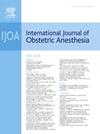产后产科出血的粘弹性测试:由以患者为中心的结果研究所(PCORI)委托进行的范围审查
IF 2.3
3区 医学
Q2 ANESTHESIOLOGY
引用次数: 0
摘要
出血是全世界孕产妇死亡的主要原因。产后出血造成的大多数死亡被认为是可以预防的。粘弹性测试可快速实时测量凝血的机械特性,从而深入了解血凝块的形成、稳定性和溶解情况。这一范围审查的目的是确定和地图使用粘弹性测试,包括血栓弹性成像和旋转血栓弹性测量,在产科产后出血。方法作为更大范围综述的一部分,我们遵循了详细的工作计划,概述了先验方法(https://osf.io/mzr6p)。2025年7月的文献检索包括从开始检索的14个数据库。PRISMA-ScR报道。结果本综述显示,产后出血粘弹性检测的证据基础越来越多。我们确定了156篇出版物中报道的106项研究,但很少有发表随机对照试验。许多观察性研究,主要发表在欧洲,记录了粘弹性测试在实践中的经验,尽管许多研究仍然只是以缩写形式发表(例如会议摘要)。采用的障碍包括成本、供应商知识和接受度、培训和研究挑战。未来的研究需要通过使用适合于罕见和不可预测事件的方法来评估粘弹性测试方案对孕产妇发病率和组织影响的影响。我们对实践和研究提出了具体建议。结论粘弹性试验可提供凝血监护点监测,为指导输血治疗提供实时决策支持。方案可以减少输血量、术后出血和防止过度治疗,但需要更多的临床指导和严格的多中心研究来确定方案在产后出血护理中的应用。本文章由计算机程序翻译,如有差异,请以英文原文为准。
Viscoelastic testing in postpartum obstetric hemorrhage: a scoping review commissioned by the Patient-Centered Outcomes Research Institute (PCORI)
Background
Hemorrhage is a leading cause of maternal mortality worldwide. Most deaths due to postpartum hemorrhage are considered preventable. Viscoelastic testing rapidly measures mechanical properties of coagulation in real time, providing insights into blood clot formation, stability and dissolution. The objective of this scoping review was to identify and map use of viscoelastic testing, including thromboelastography and rotational thromboelastometry, in obstetrics for postpartum hemorrhage.
Methods
As part of a larger landscape review, we followed a detailed workplan outlining methods a priori (https://osf.io/mzr6p). Literature searches in July 2025 included 14 databases searched from inception. Reporting followed PRISMA-ScR.
Results
The scoping review shows a growing evidence base of viscoelastic testing for postpartum hemorrhage. We identified 106 research studies reported in 156 publications, but few published randomized controlled trials. Many observational studies, predominantly published in Europe, document experiences with viscoelastic testing in practice, although many are still only published in abbreviated form (e.g. conference abstracts). Barriers to adoption include cost, provider knowledge and acceptance, training, and research challenges. Future research needs to assess the effect of viscoelastic testing protocols on maternal morbidity and organizational impact by using methods suitable for rare and largely unpredictable events. We outline specific recommendations for practice and research.
Conclusions
Viscoelastic testing offers point-of-care monitoring of coagulation, enabling real-time decision support to guide transfusion therapy. Protocols may reduce transfusion volume, postoperative bleeding, and prevent overtreatment, but more clinical guidance and rigorous multicenter studies to determine the impact of protocols for use in postpartum hemorrhage care empirically are needed.
求助全文
通过发布文献求助,成功后即可免费获取论文全文。
去求助
来源期刊
CiteScore
4.70
自引率
7.10%
发文量
285
审稿时长
58 days
期刊介绍:
The International Journal of Obstetric Anesthesia is the only journal publishing original articles devoted exclusively to obstetric anesthesia and bringing together all three of its principal components; anesthesia care for operative delivery and the perioperative period, pain relief in labour and care of the critically ill obstetric patient.
• Original research (both clinical and laboratory), short reports and case reports will be considered.
• The journal also publishes invited review articles and debates on topical and controversial subjects in the area of obstetric anesthesia.
• Articles on related topics such as perinatal physiology and pharmacology and all subjects of importance to obstetric anaesthetists/anesthesiologists are also welcome.
The journal is peer-reviewed by international experts. Scholarship is stressed to include the focus on discovery, application of knowledge across fields, and informing the medical community. Through the peer-review process, we hope to attest to the quality of scholarships and guide the Journal to extend and transform knowledge in this important and expanding area.

 求助内容:
求助内容: 应助结果提醒方式:
应助结果提醒方式:


